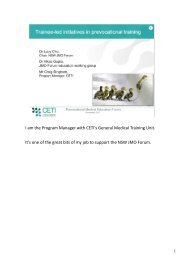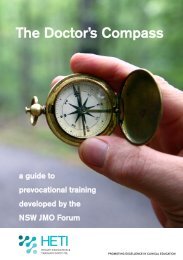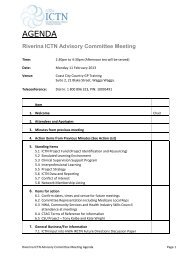Open - HETI - NSW Government
Open - HETI - NSW Government
Open - HETI - NSW Government
- No tags were found...
Create successful ePaper yourself
Turn your PDF publications into a flip-book with our unique Google optimized e-Paper software.
Establishing the supervisory relationshipIt is important to get to know your supervisee as a person and to establish a good working relationship at the outset.If you show your interest in them and their aspirations, this is likely to form the basis of a successful supervisoryexperience for both of you. Part of this initial relationship building is introducing yourself and explaining a littleof your background and your goals for supervision. it is also important to establish clear boundaries and a jointunderstanding of the supervisory relationship.The educational supervisor’s role toolkit – activitiesFor the new practitioner, the early period of the supervisory relationship is part of what is known as “professionalsocialisation”. This is the process of learning skills, attitudes, and behaviours necessary to fulfil professional roles.Brim 1 describes socialisation as preparing adults for roles so they will know what is expected of them, will meetthose expectations, and will desire to practise the expected behaviours.Early professional socialisation is influenced by multiple factors including self-concept, personal and educationalbackground, and the role of mentors, peers, and role models. 2Some questions to help build the initial supervisory relationship include:• What are your expectations of this role and of supervision?• What long term goals/aspirations do you have for your career?• What have you found challenging in the past?• What do you see as your area/s of special competence?• How do you learn best?• What level of support do you think you need?• Do you have any concerns that we need to address before you start here?• Is there anything else that you think it might be helpful for me to know?The supervisor should also discuss and establish:• the frequency of supervision sessions;• their availability and willingness to be contacted when assistance is required;• the best way for the supervisee to access advice on a day-to-day basis;• how concerns can be addressed.Taking the time to establish a joint understanding of the processes and boundaries of supervision from the startprovides a solid foundation from which to manage issues or concerns as they arise.1 Brim, O. (1968). Adult socialization. In: Clausen, J. (ed) Socialization and society. Boston: Little Brown, 182-226.2 Blue, C. M., & Lopez, N. (2011). Towards building the oral health care workforce: who are the new dental therapists? Journal Of Dental Education, 75(1),36-45.FIRST EDITION<strong>HETI</strong> The Superguide79
















